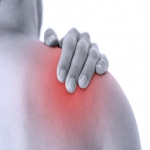
Picture this scenario: you were commissioned to take down the Christmas lights off the house in January. As you were performing the “honey-do” task with due diligence, your foot slipped on the ladder. You reached to grab the overhang and caught yourself from falling but felt a slight “twinge” in your shoulder. Thinking nothing of it, you continued to work and completed your task. That evening your shoulder was sore and you took some Tylenol. The next day or two, your pain continued and now several months later, you have decided you may have in fact injured your shoulder.
This may not be your scenario, but you are reading this because you may, in the past, or may now have shoulder pain. In fact, reaching for a carton of milk in the refrigerator or combing your hair has become quite the painful task.
A cause of this pain could be due to inflammation. Inflammation is relatively common in the shoulder and may occur in the rotator cuff tendons, the bursa (a sac of fluid that cushions the shoulder during movement) or the upper portion of the biceps tendon.
Rotator Cuff Tendonitis
Rotator cuff tendonitis, Impingement Syndrome or Subacromial Bursitis are terms used often interchangeably to indicate inflammation in the structures of the shoulder. Causes of this problem could be from an acute injury that developed inflammation in the shoulder, repetitive (chronic) overhead motion or from your own anatomy.
In the shoulder there is a space between the acromion (end of the collar bone) and the rotator cuff tendons. This space is called the subacromial space and has a bursa present in the area called the subacromial bursa. If this space is narrowed, whether by inflammation of the tendon, the bursa or from a more “hooked” acromion (also called a type II or type III acromion); then the shoulder may become painful with overhead motion or reaching behind your back.
Dr. Robert Bruce from Kansas City Bone & Joint Clinic often sees patients with rotator cuff injuries. He notes that patients typically have problems putting on their belt and combing their hair. These activities of daily living being limited will bring patients in for more aggressive treatment options.
Treatment Options
Several treatment options are available for rotator cuff tendonitis and it is typically recommended to begin with the least invasive options and progressing as needed.
- Ice- Ice decreases inflammation to the area. Icing should be performed every 2 hours for 20 minutes. Click here to discover more tips on icing.
- Heat- Heat may make the area feel better but it will not reduce the inflammation. If you are going to use heat, it is recommended that you follow it up with ice.
- Medications- You may try over the counter medications such as Aleve or Advil, per your primary care physician’s approval or your provider may prescribe medications to reduce inflammation.
- Physical Therapy- Whether on your own or with a therapist, strengthening the muscles surrounding the shoulder will help improve posture and prevent further discomfort. Click here to discover sample exercises for the shoulder.
- Cortisone Injections- Your provider may recommend an injection to the subacromial space to reduce inflammation. Click here to discover more information regarding cortisone injections
- Ultimately, if your pain persists after exhausting conservative options, surgical options could be considered to “clean up” (debride) the areas of inflammation and possibly address the acromion anatomy.
Go to part 1: Rotator Cuff, The Injury
Go to part 3: Rotator Cuff Tear

